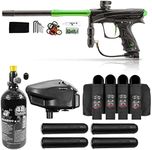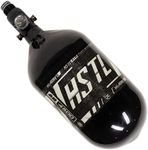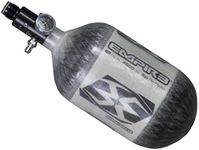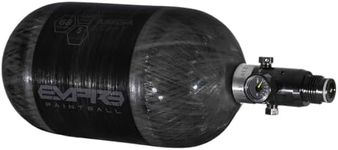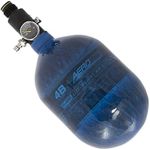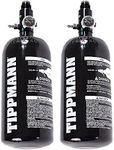Buying Guide for the Best Paintball Tanks
Choosing the right paintball tank is crucial for ensuring a smooth and enjoyable paintball experience. The tank is responsible for providing the necessary air pressure to propel the paintballs from your marker. When selecting a paintball tank, you need to consider several key specifications to ensure it meets your needs and preferences. Understanding these specifications will help you make an informed decision and enhance your overall gameplay.Tank TypeThere are two main types of paintball tanks: CO2 and High-Pressure Air (HPA). CO2 tanks are more affordable and widely available, but they can be inconsistent in performance, especially in varying temperatures. HPA tanks, on the other hand, provide more consistent performance and are preferred by serious players. If you are a beginner or play casually, a CO2 tank might be sufficient. However, if you play frequently or competitively, an HPA tank is a better choice.
Tank SizeTank size is measured in cubic inches (ci) for HPA tanks and ounces for CO2 tanks. The size determines how much air the tank can hold, which affects how many shots you can fire before needing a refill. Common HPA tank sizes include 48ci, 68ci, and 90ci, while CO2 tanks typically range from 9oz to 20oz. A larger tank will provide more shots but will also be heavier and bulkier. Consider your playing style and how often you want to refill your tank when choosing the size. For longer games or scenarios, a larger tank is beneficial, while for shorter, fast-paced games, a smaller, lighter tank may be preferable.
Tank PressureHPA tanks come in different pressure ratings, commonly 3000 psi and 4500 psi. The pressure rating indicates the maximum pressure the tank can safely hold. A higher pressure tank (4500 psi) will generally provide more shots per fill compared to a lower pressure tank (3000 psi). If you play frequently and want to minimize the number of refills, a higher pressure tank is advantageous. However, ensure that your paintball marker is compatible with the pressure rating of the tank you choose.
RegulatorThe regulator controls the output pressure from the tank to the paintball marker. A good regulator ensures consistent air flow, which translates to consistent shot velocity and accuracy. Some tanks come with adjustable regulators, allowing you to fine-tune the output pressure. If you are a beginner, a fixed regulator should suffice. For more advanced players who want to optimize their marker's performance, an adjustable regulator is a valuable feature.
MaterialPaintball tanks are typically made from aluminum or carbon fiber. Aluminum tanks are more affordable and durable but are heavier. Carbon fiber tanks are lighter and can hold higher pressures, making them ideal for competitive play, but they are more expensive. If you prioritize weight and performance, a carbon fiber tank is the way to go. For casual play or if you are on a tighter budget, an aluminum tank will still perform adequately.
Hydro TestingHydro testing is a safety test that paintball tanks must undergo periodically to ensure they can safely hold the required pressure. CO2 tanks typically need to be hydro tested every 5 years, while HPA tanks may vary between 3 to 5 years depending on the manufacturer. When purchasing a tank, check the hydro test date to ensure it is current. If you are buying a used tank, make sure it has been recently tested or factor in the cost and inconvenience of getting it tested soon.

